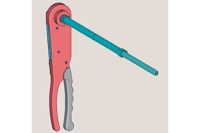Testing services company Intertek checks thousands of medical devices each year to determine their conformity to various standards and regulations. Incredibly, the London-based company has found that more than 90 percent of electronic medical devices fail to comply with these requirements on the first submission.
Reworking a device because it fails to conform with standards often means costly delays. By detecting these errors early in the design and manufacturing stages, engineers can ensure their device gets to market on time and on budget.
According to Intertek, the following are the top 10 sources for noncompliance:
- Electromagnetic compatibility (EMC).
- Package markings.
- Symbols, labels and markings.
- Operating instructions.
- Creepage and clearance distances.
- Indicator colors.
- Transformers and power supplies.
- Wire thickness.
- Cleaning, disinfection and sterilization.
- Grounding wire colors.
The most frequent source of EMC problems is radio frequency emissions from the device. The most common design errors causing EMC problems include:
- Using generic components not specifically designed for medical devices.
- Not making good metal-to-metal contact around enclosures.
- Large holes in enclosures.
- Using plastic enclosures around “noisy” circuits.
- Ground wires that are too long or too thin.
- Electrostatic discharge to membrane switches, keyboards and other components.
Some 90 percent of medical devices tested by Intertek have poorly marked packaging. International Electrotechnical Commission (IEC) standard
60601 stipulates that if the device requires special measures during transport or storage, the packaging must be marked accordingly. For example, the package should indicate what’s in it, how it should be oriented, and the minimum and maximum temperatures for transport and storage.
Creepage and clearance distances are problematic in more than 80 percent of the devices tested by Intertek. Errors with these distances usually call for redesigning the device, so getting them right the first time is critical for staying on schedule.
Creepage is the shortest path between two conductive parts (or between a conductive part and the bounding surface of the device), as measured along the surface of the insulation. Adequate creepage distance protects against current flowing over the surface of the insulation.
Clearance is the shortest distance between two conductive parts (or between a conductive part and the bounding surface of the equipment), as measured through the air. Proper clearance prevents current from jumping between circuits through the air.
Although IEC 60601 states that the color red on equipment should be reserved exclusively to indicate danger or the need for urgent action, many medical device manufacturers use red lights for routine indication purposes. Additionally, yellow indicators are often inappropriately used where green lights should be used.
Another common problem is wiring, whether insulated or printed, that is too thin for the circuit to which it is connected. This is frequently an issue where outputs for power are provided. The wires coming off a connector on a printed circuit board might be compliant, but the traces to the female connector on the board are frequently undersized. This could cause the connector pins to heat up, possibly resulting in an open circuit.
For more on Intertek’s findings, click here: www.intertek.com/medical/10-reasons-medical-devices-fail-testing-paper.

